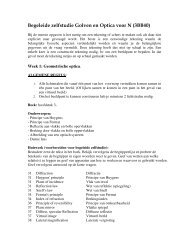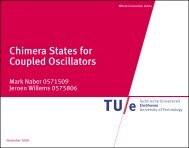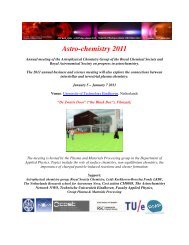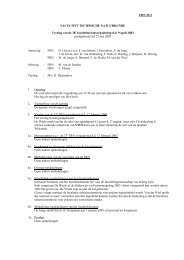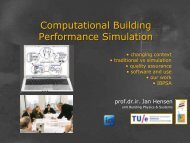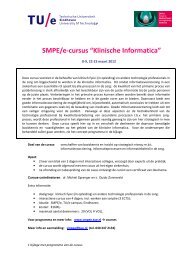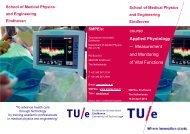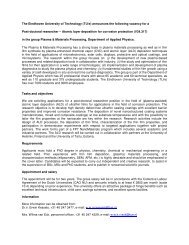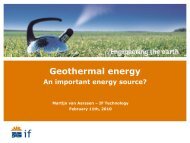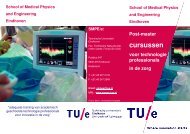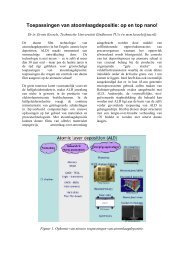Sustainable Nuclear Energy - Eindhoven University of Technology
Sustainable Nuclear Energy - Eindhoven University of Technology
Sustainable Nuclear Energy - Eindhoven University of Technology
Create successful ePaper yourself
Turn your PDF publications into a flip-book with our unique Google optimized e-Paper software.
<strong>Sustainable</strong> <strong>Nuclear</strong> <strong>Energy</strong>What are the scientific and technological challenges<strong>of</strong> safe, clean and abundant nuclear energy?Tim van der HagenDelft <strong>University</strong> <strong>of</strong> <strong>Technology</strong>14-12-2009vision from 1939Delft<strong>University</strong> <strong>of</strong><strong>Technology</strong>Challenge the futureTim van der Hagen; TU/e <strong>Energy</strong> Day; 10.12.2009; <strong>Eindhoven</strong> 1
1954: Launching <strong>of</strong> Nautilus14-12-2009Delft<strong>University</strong> <strong>of</strong><strong>Technology</strong>Challenge the futureTim van der Hagen; TU/e <strong>Energy</strong> Day; 10.12.2009; <strong>Eindhoven</strong> 3
Nautilus passes the pole14-12-2009Delft<strong>University</strong> <strong>of</strong><strong>Technology</strong>Challenge the futureTim van der Hagen; TU/e <strong>Energy</strong> Day; 10.12.2009; <strong>Eindhoven</strong> 4
<strong>Nuclear</strong> fissionradioactive14-12-2009Fissioning <strong>of</strong> 1 gram uranium yields as much energy asburning 2500 liters petrolor 3000 kilograms coalDelft<strong>University</strong> <strong>of</strong><strong>Technology</strong>Challenge the futureTim van der Hagen; TU/e <strong>Energy</strong> Day; 10.12.2009; <strong>Eindhoven</strong> 5
CO 2 production1500CO 2 (g/kWh e )14-12-200912009006003000kolen olie gas zon PV water bio wind nucleair fusiecoal oil gas solar PV hydro bio wind nuclear fusionSource: IAEA (2000)Delft<strong>University</strong> <strong>of</strong><strong>Technology</strong>Challenge the futureTim van der Hagen; TU/e <strong>Energy</strong> Day; 10.12.2009; <strong>Eindhoven</strong> 6
Costs <strong>of</strong> nuclear electricity production0,1 ct/kWh e14-12-20090,1 ct/kWh eDelft<strong>University</strong> <strong>of</strong><strong>Technology</strong>Challenge the futureTim van der Hagen; TU/e <strong>Energy</strong> Day; 10.12.2009; <strong>Eindhoven</strong> 7
IEA <strong>Energy</strong> <strong>Technology</strong> Perspectives 2008June 6, 200814-12-2009Delft<strong>University</strong> <strong>of</strong><strong>Technology</strong>Challenge the futureTim van der Hagen; TU/e <strong>Energy</strong> Day; 10.12.2009; <strong>Eindhoven</strong> 8
IEA <strong>Energy</strong> <strong>Technology</strong> Perspectives 2008June 6, 200814-12-2009Delft<strong>University</strong> <strong>of</strong><strong>Technology</strong>Challenge the futureTim van der Hagen; TU/e <strong>Energy</strong> Day; 10.12.2009; <strong>Eindhoven</strong> 9
Electricity production in the EU2007geo thermal 0.2 %fossilwind 3.1 %biomass 2.7 %14-12-2009nuclearhydrosolar 0.1 %waste 0.6 %hydropower 10.1 %nuclear 27.7 %fossil 56.5 %Source: Observ’ER (2008)Delft<strong>University</strong> <strong>of</strong><strong>Technology</strong>Challenge the futureTim van der Hagen; TU/e <strong>Energy</strong> Day; 10.12.2009; <strong>Eindhoven</strong> 10
<strong>Nuclear</strong> Power Plants in operation14-12-2009Totaal 443 centralesIn total 439 NPPs 370.000 MWe 372,059 MWeNetherlandsDelft<strong>University</strong> <strong>of</strong><strong>Technology</strong>Challenge the futureTim van der Hagen; TU/e <strong>Energy</strong> Day; 10.12.2009; <strong>Eindhoven</strong> 11
<strong>Nuclear</strong> Power Plants14-12-2009Delft<strong>University</strong> <strong>of</strong><strong>Technology</strong>Challenge the futureTim van der Hagen; TU/e <strong>Energy</strong> Day; 10.12.2009; <strong>Eindhoven</strong> 12
Status nuclear power plansJanuary 2008300250planned (316)construction (34) now 53in operation (439)gepland (316)in aanbouw (34)in bedrijf (439)20015014-12-20091005001 2 3 4 5Asia Western Eastern N.- and S.-Europe Europe AmericaAfricaDelft<strong>University</strong> <strong>of</strong><strong>Technology</strong>Challenge the futureTim van der Hagen; TU/e <strong>Energy</strong> Day; 10.12.2009; <strong>Eindhoven</strong> 13
<strong>Energy</strong> release for fission <strong>of</strong> 235 U235U + n→ X + Y + ν n + 207 MeVX14-12-2009YDelft<strong>University</strong> <strong>of</strong><strong>Technology</strong>Challenge the futureTim van der Hagen; TU/e <strong>Energy</strong> Day; 10.12.2009; <strong>Eindhoven</strong> 14
Maintaining a chain reaction1 neutron produces ~ 2.5 neutrons from23592 UCould be a self-sustaining chain reaction!14-12-2009Could be used for power production‘in some kind <strong>of</strong> machine’: HOW?Delft<strong>University</strong> <strong>of</strong><strong>Technology</strong>Challenge the futureTim van der Hagen; TU/e <strong>Energy</strong> Day; 10.12.2009; <strong>Eindhoven</strong> 15
Cross sections(interaction probability)235U238Utotal14-12-2009totalcapturefissioncapturefissionNeutron energy / eVNeutron energy / eVNeutrons have to be slowed down (moderated)to keep the chain reaction going(moderator: water, graphite)Delft<strong>University</strong> <strong>of</strong><strong>Technology</strong>Challenge the futureTim van der Hagen; TU/e <strong>Energy</strong> Day; 10.12.2009; <strong>Eindhoven</strong> 16
Enrichment neededUranium ore contains 0.7 % <strong>of</strong> fissile 235 Ubut14-12-2009most commercial reactors use 3-4 %Delft<strong>University</strong> <strong>of</strong><strong>Technology</strong>Challenge the futureTim van der Hagen; TU/e <strong>Energy</strong> Day; 10.12.2009; <strong>Eindhoven</strong> 17
fissile – fissionable – fertile• Fissile isotopes (can be fissioned by neutron capture):233U, 235 U, 239 Pu, 241 Pu (rare)14-12-2009• Fissionable isotopes (threshold in neutron energy):232Th, 233 Th, 234 U, 236 U, 238 U , 239 U, 240 Pu, 242 Pu …• Fertile isotopes (can be turned into a fissile isotope):232Th, 238 UDelft<strong>University</strong> <strong>of</strong><strong>Technology</strong>Challenge the futureTim van der Hagen; TU/e <strong>Energy</strong> Day; 10.12.2009; <strong>Eindhoven</strong> 18
Production <strong>of</strong> fissile isotopes (conversion)+ n →−238 239 β 239 β 23992 92⎯⎯⎯⎯⎯→23 5 93⎯⎯⎯⎯→. min 23 . d 94U U Np Pu−14-12-2009extra neutron needed+ n →232 233 β 233 β 23390 90⎯⎯⎯⎯⎯→22 3 91⎯⎯⎯⎯→. min 27 d 92−Th Th Pa U−Delft<strong>University</strong> <strong>of</strong><strong>Technology</strong>Challenge the futureTim van der Hagen; TU/e <strong>Energy</strong> Day; 10.12.2009; <strong>Eindhoven</strong> 19
If more fissile isotopes are producedfrom fertile isotopes than weredestroyed in the chain reaction:breeding14-12-2009Delft<strong>University</strong> <strong>of</strong><strong>Technology</strong>Challenge the futureTim van der Hagen; TU/e <strong>Energy</strong> Day; 10.12.2009; <strong>Eindhoven</strong> 20
Number <strong>of</strong> neutrons per neutron absorption# neutrons per absorption14-12-2009thermalbreeding233Ufastbreeding239Pubreedingpossiblechain reactionpossibleneutron energy / eVDelft<strong>University</strong> <strong>of</strong><strong>Technology</strong>Challenge the futureTim van der Hagen; TU/e <strong>Energy</strong> Day; 10.12.2009; <strong>Eindhoven</strong> 21
14-12-2009It is important to realize that:• The fact that η > 1 makesa chain reaction possible• The fact that η > 2 makesbreeding possibleA small miracle!Delft<strong>University</strong> <strong>of</strong><strong>Technology</strong>Challenge the futureTim van der Hagen; TU/e <strong>Energy</strong> Day; 10.12.2009; <strong>Eindhoven</strong> 22
neutronU-235Moderator14-12-2009U-238U-235U-239ModeratorNp-239U-238 Pu-239Delft<strong>University</strong> <strong>of</strong><strong>Technology</strong>Pu-239Challenge the futureTim van der Hagen; TU/e <strong>Energy</strong> Day; 10.12.2009; <strong>Eindhoven</strong> 23
The nuclear reactorreflector14-12-2009Moderator for slowing down theneutronsFuel where fission occurs and heatis producedControl rods that absorb neutronsshutting down the reactorReflector to scatter back neutronsSystem to transport heat (coldleg/hot leg)Delft<strong>University</strong> <strong>of</strong><strong>Technology</strong>Challenge the futureTim van der Hagen; TU/e <strong>Energy</strong> Day; 10.12.2009; <strong>Eindhoven</strong> 24
The nuclear reactor14-12-2009Delft<strong>University</strong> <strong>of</strong><strong>Technology</strong>Challenge the futureTim van der Hagen; TU/e <strong>Energy</strong> Day; 10.12.2009; <strong>Eindhoven</strong> 25
Fuel tabletsComposition <strong>of</strong>:5% 235 U95% 238 U(0.7% 235 U in natural ore)14-12-2009Delft<strong>University</strong> <strong>of</strong><strong>Technology</strong>Challenge the futureTim van der Hagen; TU/e <strong>Energy</strong> Day; 10.12.2009; <strong>Eindhoven</strong> 26
Fuel Rod and Fuel Assembly14-12-2009Delft<strong>University</strong> <strong>of</strong><strong>Technology</strong>Challenge the futureTim van der Hagen; TU/e <strong>Energy</strong> Day; 10.12.2009; <strong>Eindhoven</strong> 27
Boiling Water Reactor14-12-2009Delft<strong>University</strong> <strong>of</strong><strong>Technology</strong>Challenge the futureTim van der Hagen; TU/e <strong>Energy</strong> Day; 10.12.2009; <strong>Eindhoven</strong> 28
<strong>Nuclear</strong> Fuel Cycle14-12-2009Delft<strong>University</strong> <strong>of</strong><strong>Technology</strong>Challenge the futureTim van der Hagen; TU/e <strong>Energy</strong> Day; 10.12.2009; <strong>Eindhoven</strong> 29
Element abundance in earth's crustC SiOFeCo Ni CuAgPtAuSnPb14-12-2009ThUDelft<strong>University</strong> <strong>of</strong><strong>Technology</strong>Challenge the futureTim van der Hagen; TU/e <strong>Energy</strong> Day; 10.12.2009; <strong>Eindhoven</strong> 31
Uranium resources:• The earth’s crust contains 40 x as much uranium as silver;as much uranium as tin• Cheap uranium (up to 130$ per kg): 5.5 million tons;enough for 80 years (0.1 ct/kWh)• For the double price:10 times as much; enough for 800 yearsusing fast reactors: 80,000 years14-12-2009• Uranium as byproduct from phosphate deposits(22 Mt recoverable)• Uranium from seawater (450$ per kg): 4 billion tons;enough for 6,000,000 yearsSource: OECD NEA & IAEA, “Uranium 2007: Resources, Production and Demand“("Red Book").Delft<strong>University</strong> <strong>of</strong><strong>Technology</strong>Challenge the futureTim van der Hagen; TU/e <strong>Energy</strong> Day; 10.12.2009; <strong>Eindhoven</strong> 32
Enrichment technique 1: Gas diffusionUF 614-12-2009Delft<strong>University</strong> <strong>of</strong><strong>Technology</strong>Challenge the futureTim van der Hagen; TU/e <strong>Energy</strong> Day; 10.12.2009; <strong>Eindhoven</strong> 33
Gas diffusion cascades14-12-2009Delft<strong>University</strong> <strong>of</strong><strong>Technology</strong>Challenge the futureTim van der Hagen; TU/e <strong>Energy</strong> Day; 10.12.2009; <strong>Eindhoven</strong> 34
Enrichment technique 2: Centrifuger14-12-2009pr ()nn235238( r)( r)Schematic <strong>of</strong> a centrifugeωDelft<strong>University</strong> <strong>of</strong><strong>Technology</strong>Challenge the futureTim van der Hagen; TU/e <strong>Energy</strong> Day; 10.12.2009; <strong>Eindhoven</strong> 35
Centrifuge cascades14-12-2009Delft<strong>University</strong> <strong>of</strong><strong>Technology</strong>Challenge the futureTim van der Hagen; TU/e <strong>Energy</strong> Day; 10.12.2009; <strong>Eindhoven</strong> 36
<strong>Energy</strong> balance ( (Life Cycle Analysis)(1000 MWe PWR, 80% availability, 40 years <strong>of</strong> operation)wastestorage &transport67decommis-sioningenergy input (centrifuge)mining &input / output = 1,7 %milling 1conversion214-12-2009enrichment with centrifuges:input / output = 1,7 %5construction &operationenrichmentfuelfabrication43Delft<strong>University</strong> <strong>of</strong><strong>Technology</strong>Challenge the futureTim van der Hagen; TU/e <strong>Energy</strong> Day; 10.12.2009; <strong>Eindhoven</strong> 37
Spent Fuel Composition14-12-2009Delft<strong>University</strong> <strong>of</strong><strong>Technology</strong>Challenge the futureTim van der Hagen; TU/e <strong>Energy</strong> Day; 10.12.2009; <strong>Eindhoven</strong> 38
U-235Moderator14-12-2009U-238U-235ActinidesConversionNp-239U-239Fission productsBreedingDelft<strong>University</strong> <strong>of</strong><strong>Technology</strong>Pu-239Challenge the futureTim van der Hagen; TU/e <strong>Energy</strong> Day; 10.12.2009; <strong>Eindhoven</strong> 39
Spent fuel: only 4% is wastespent fuel1%plutonium95%uranium14-12-20094%fissionproductsDelft<strong>University</strong> <strong>of</strong><strong>Technology</strong>Challenge the futureTim van der Hagen; TU/e <strong>Energy</strong> Day; 10.12.2009; <strong>Eindhoven</strong> 40
Yearly production <strong>of</strong> actinidesElementBorssele(kg/year)Uranium 950014-12-2009PlutoniumNeptunium1005Americium5Curium0.5Delft<strong>University</strong> <strong>of</strong><strong>Technology</strong>Challenge the futureTim van der Hagen; TU/e <strong>Energy</strong> Day; 10.12.2009; <strong>Eindhoven</strong> 41
Radiotoxicity <strong>of</strong> spent fuel10 910 8ActinidesFiss ProdsOre10 7Radiotoxicity (Sv)14-12-200910 610 510 410 310 210 1 10 2 10 3 10 4 10 5 10 6Storage time (a)Delft<strong>University</strong> <strong>of</strong><strong>Technology</strong>Challenge the futureTim van der Hagen; TU/e <strong>Energy</strong> Day; 10.12.2009; <strong>Eindhoven</strong> 42
Radiotoxicity per element10 910 810 7PuAmCmOreFiss ProdsRadiotoxicity (Sv)10 610 514-12-200910 4‘transmute’ Pu10 310 210 1 10 2 10 3 10 4 10 5 10 6Storage time (a)Delft<strong>University</strong> <strong>of</strong><strong>Technology</strong>Challenge the futureTim van der Hagen; TU/e <strong>Energy</strong> Day; 10.12.2009; <strong>Eindhoven</strong> 43
Fast reactors can fission actinides,like plutonium10 10 <strong>Energy</strong> (eV)fission probabilityα (σ fis/σ cap)14-12-200910 810 610 410 210 0Pu-239Pu-240Pu-241Pu-24210 -210 -410 0 10 2 10 4 10 6neutron energy /eVDelft<strong>University</strong> <strong>of</strong><strong>Technology</strong>Challenge the futureTim van der Hagen; TU/e <strong>Energy</strong> Day; 10.12.2009; <strong>Eindhoven</strong> 44
<strong>Nuclear</strong> Fuel Cycle: conclusions• spent fuel consists <strong>of</strong>‣ fission products (Borssele: 450 kg)‣ unused Uranium (Borssele: 9500 kg)‣ plutonium and americium (Borssele: 100+5 kg)• fission products are harmless after 250 years• americum is harmless after 5000 years14-12-2009• plutonium is fuel, not waste• ‘Borssele’ produces 1.3 m 3 high-level waste each year(encapsulated) ⇒ 2 cm 3 per person if all electricity would begenerated using nuclear energy• The stronger waste irradiates, the sooner it becomes harmlessDelft<strong>University</strong> <strong>of</strong><strong>Technology</strong>Challenge the futureTim van der Hagen; TU/e <strong>Energy</strong> Day; 10.12.2009; <strong>Eindhoven</strong> 45
Safety <strong>of</strong> <strong>Nuclear</strong> Reactors14-12-2009Delft<strong>University</strong> <strong>of</strong><strong>Technology</strong>Challenge the futureTim van der Hagen; TU/e <strong>Energy</strong> Day; 10.12.2009; <strong>Eindhoven</strong> 46
Safety <strong>of</strong> nuclear power plantsmultiple barriers to keep radioactive nuclides inside14-12-2009Fuel (pellet and cladding)Primary system (steel)Containments(2x concrete + steel)Delft<strong>University</strong> <strong>of</strong><strong>Technology</strong>Challenge the futureTim van der Hagen; TU/e <strong>Energy</strong> Day; 10.12.2009; <strong>Eindhoven</strong> 47
Inherent safety: chain reactionU-235ModeratorModerator feedback14-12-2009Doppler feedbackU-238U-235Delft<strong>University</strong> <strong>of</strong><strong>Technology</strong>Challenge the futureNp-239U-2391) Stable system2) Loss <strong>of</strong> coolant shuts down reactor immediately3) Loss <strong>of</strong> moderation shuts down the reactorTim van der Hagen; TU/e <strong>Energy</strong> Day; 10.12.2009; <strong>Eindhoven</strong> 48
Decay heat per MW nominal powerDecay power / MW14-12-2009Decay energy / MWdTime / dayCore cooling is always needed, also after shutdown !Delft<strong>University</strong> <strong>of</strong><strong>Technology</strong>Challenge the futureTim van der Hagen; TU/e <strong>Energy</strong> Day; 10.12.2009; <strong>Eindhoven</strong> 49
Overview <strong>of</strong> <strong>Nuclear</strong> Power Reactors14-12-2009Delft<strong>University</strong> <strong>of</strong><strong>Technology</strong>Challenge the futureTim van der Hagen; TU/e <strong>Energy</strong> Day; 10.12.2009; <strong>Eindhoven</strong> 50
Generations <strong>of</strong> nuclear reactorsGeneration IEarly PrototypeReactors- Shippingport- Dresden, Fermi I- Magnox14-12-2009Generation IICommercial PowerReactors- LWR-PWR, BWR- CANDU- VVER/RBMKGeneration IIIAdvancedLWRs- ABWR- System 80+- AP600- EPREvolutionaryDesigns OfferingImprovedEconomics1950 1960 1970 1980 1990 2000 2010 2020 2030Generation IV- HighlyEconomical- EnhancedSafety- MinimalWaste- ProliferationResistantGen I Gen II Gen III Gen IVDelft<strong>University</strong> <strong>of</strong><strong>Technology</strong>Challenge the futureTim van der Hagen; TU/e <strong>Energy</strong> Day; 10.12.2009; <strong>Eindhoven</strong> 51
European Pressurized Water Reactorreactor building4500 MWturbine building14-12-2009reactorvessel4 safety buildings4 x 100%Delft<strong>University</strong> <strong>of</strong><strong>Technology</strong>Challenge the futureTim van der Hagen; TU/e <strong>Energy</strong> Day; 10.12.2009; <strong>Eindhoven</strong> 52
Double containment–Concrete ––Steel ––Concrete –14-12-2009 Resistantagainst impact<strong>of</strong> largeairplaneDelft<strong>University</strong> <strong>of</strong><strong>Technology</strong>Challenge the futureTim van der Hagen; TU/e <strong>Energy</strong> Day; 10.12.2009; <strong>Eindhoven</strong> 53
Passively cooled ‘Core Catcher’cooling water14-12-2009Delft<strong>University</strong> <strong>of</strong><strong>Technology</strong>Challenge the futureTim van der Hagen; TU/e <strong>Energy</strong> Day; 10.12.2009; <strong>Eindhoven</strong> 54
Advanced Passive PWR1117 MWe (Westinghouse – VS)14-12-2009Delft<strong>University</strong> <strong>of</strong><strong>Technology</strong>Challenge the futureTim van der Hagen; TU/e <strong>Energy</strong> Day; 10.12.2009; <strong>Eindhoven</strong> 55
Passive emergency cooling<strong>of</strong> the containment14-12-2009Delft<strong>University</strong> <strong>of</strong><strong>Technology</strong>Challenge the futureTim van der Hagen; TU/e <strong>Energy</strong> Day; 10.12.2009; <strong>Eindhoven</strong> 56
Passive safety due to fewercomponents and less piping14-12-2009Delft<strong>University</strong> <strong>of</strong><strong>Technology</strong>Challenge the futureTim van der Hagen; TU/e <strong>Energy</strong> Day; 10.12.2009; <strong>Eindhoven</strong> 57
High Temperature Reactor generation IIIgeneration III +AVR (Germany, 1967-1988) – HTTR (Japan, 1999) – HTR10 (China, 2000)helium ascoolantgasturbine14-12-2009process heat:hydrogen productionwater desalination ...inherently safeDelft<strong>University</strong> <strong>of</strong><strong>Technology</strong>Challenge the futureTim van der Hagen; TU/e <strong>Energy</strong> Day; 10.12.2009; <strong>Eindhoven</strong> 58
Fuel Pebble with TRISO particles14-12-2009Delft<strong>University</strong> <strong>of</strong><strong>Technology</strong>Challenge the futureTim van der Hagen; TU/e <strong>Energy</strong> Day; 10.12.2009; <strong>Eindhoven</strong> 59
Generations <strong>of</strong> nuclear reactorsGeneration IEarly PrototypeReactors- Shippingport- Dresden, Fermi I- Magnox14-12-2009Generation IICommercial PowerReactors- LWR-PWR, BWR- CANDU- VVER/RBMKGeneration IIIAdvancedLWRs- ABWR- System 80+- AP600- EPREvolutionaryDesigns OfferingImprovedEconomics1950 1960 1970 1980 1990 2000 2010 2020 2030Generation IV- HighlyEconomical- EnhancedSafety- MinimalWaste- ProliferationResistantGen I Gen II Gen III Gen IVDelft<strong>University</strong> <strong>of</strong><strong>Technology</strong>Challenge the futureTim van der Hagen; TU/e <strong>Energy</strong> Day; 10.12.2009; <strong>Eindhoven</strong> 60
14-12-2009Gen-IV Roadmap(2002, 97 pages)Delft<strong>University</strong> <strong>of</strong><strong>Technology</strong>Challenge the futureTim van der Hagen; TU/e <strong>Energy</strong> Day; 10.12.2009; <strong>Eindhoven</strong> 61
The Generation-IVInitiative: sustainable nuclear energyArgentine, Brazil, Canada, France, Japan, South Africa, South Korea,Switzerland, United Kingdom, United States and the European UnionThe 6 selected reactor conceptsHydrogen production:• Very High Temperature Gas Cooled ReactorEvolution <strong>of</strong> Light Water Reactors:• Supercritical Water Cooled Reactor (thermal/fast)14-12-2009 Waste reduction and high efficiency:• Gas Cooled Fast Reactor• Sodium Cooled Fast Reactor• Lead Cooled Fast Reactorclosedfuel cycleVery innovative:• Molten Salt Reactor (epithermal)Delft<strong>University</strong> <strong>of</strong><strong>Technology</strong>Challenge the futureTim van der Hagen; TU/e <strong>Energy</strong> Day; 10.12.2009; <strong>Eindhoven</strong> 62
Six reactor types in Gen-IV14-12-2009Delft<strong>University</strong> <strong>of</strong><strong>Technology</strong>Challenge the futureTim van der Hagen; TU/e <strong>Energy</strong> Day; 10.12.2009; <strong>Eindhoven</strong> 63
<strong>Sustainable</strong> <strong>Nuclear</strong> <strong>Energy</strong><strong>Technology</strong> PlatformStrategic Research Agenda(2009, 87 pages)14-12-2009Delft<strong>University</strong> <strong>of</strong><strong>Technology</strong>Challenge the futureTim van der Hagen; TU/e <strong>Energy</strong> Day; 10.12.2009; <strong>Eindhoven</strong> 64
Research themes Gen-IV• fuel (fast reactors, transmutation, high burn-up, thorium cycle …)• materials (corrosion, embrittlement, radiation damage, high temperatures)• heat transport• multiphase flows• neutron data (cross sections <strong>of</strong> materials)• chemical treatment <strong>of</strong> spent fuel14-12-2009 • core design• system design (safety, efficiency, flexibility, …)• safety (decay heat removal)• coupling nuclear heat – process heat (hydrogen production)• gas turbinesDelft<strong>University</strong> <strong>of</strong><strong>Technology</strong>Challenge the futureTim van der Hagen; TU/e <strong>Energy</strong> Day; 10.12.2009; <strong>Eindhoven</strong> 65
eactor calculationsdisciplines / time scalesneutronics< 10 -4 sec / sec – minutesradioactive decayseconds - monthsfeedback14-12-2009heat transfer10 secburn-upweeks - monthscontrolminutes - hoursfluid dynamics10 secfuel cycleyearsDelft<strong>University</strong> <strong>of</strong><strong>Technology</strong>Challenge the futureTim van der Hagen; TU/e <strong>Energy</strong> Day; 10.12.2009; <strong>Eindhoven</strong> 66
The Dutch nuclear sectorNRGURENCORID14-12-2009COVRAKCBDelft<strong>University</strong> <strong>of</strong><strong>Technology</strong>Challenge the futureTim van der Hagen; TU/e <strong>Energy</strong> Day; 10.12.2009; <strong>Eindhoven</strong> 67
14-12-2009Delft<strong>University</strong> <strong>of</strong><strong>Technology</strong>Challenge the futureTim van der Hagen; TU/e <strong>Energy</strong> Day; 10.12.2009; <strong>Eindhoven</strong> 68



